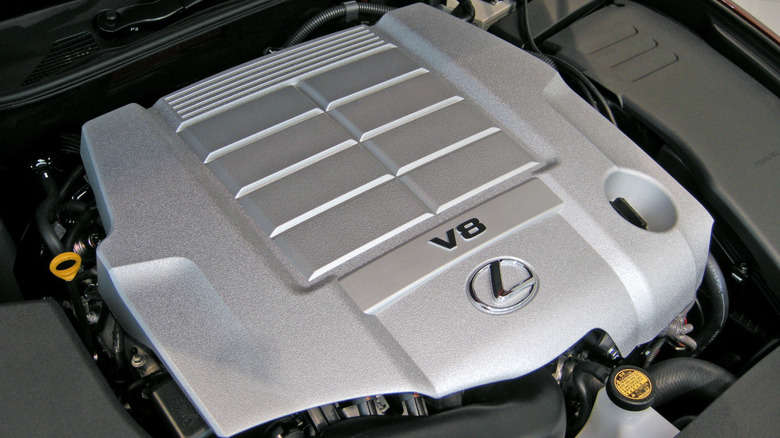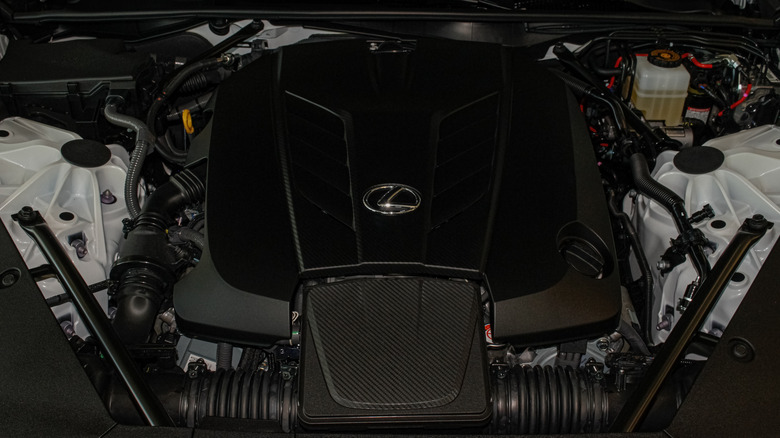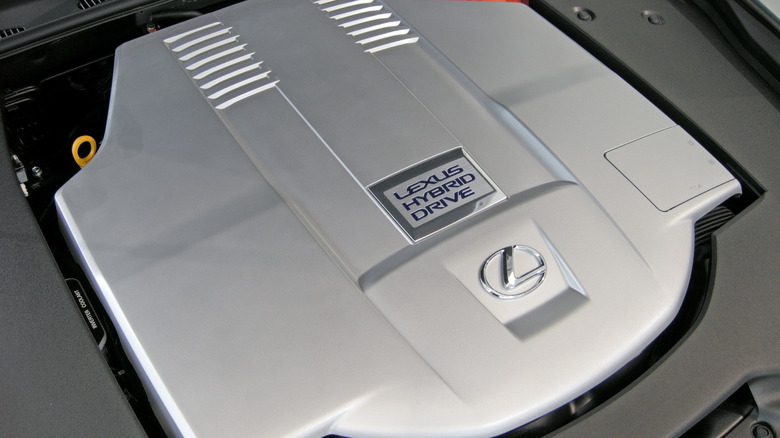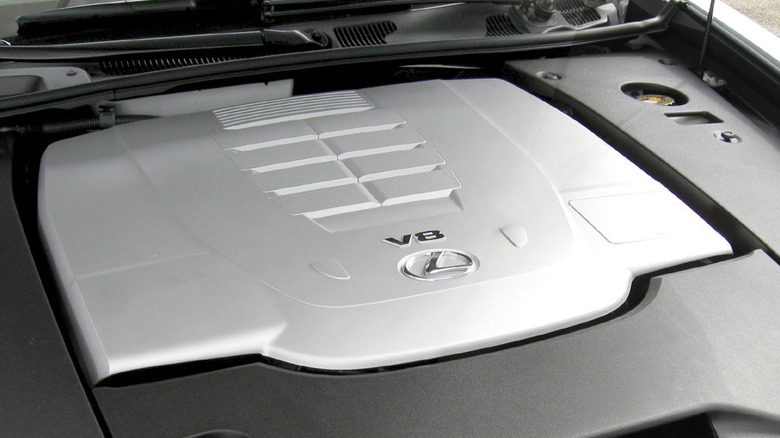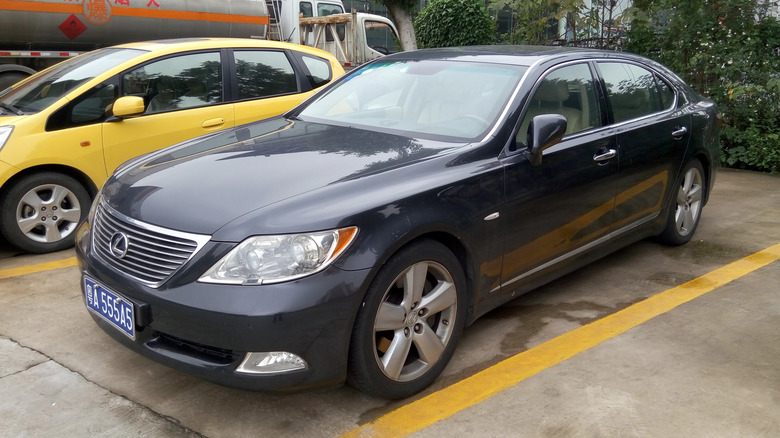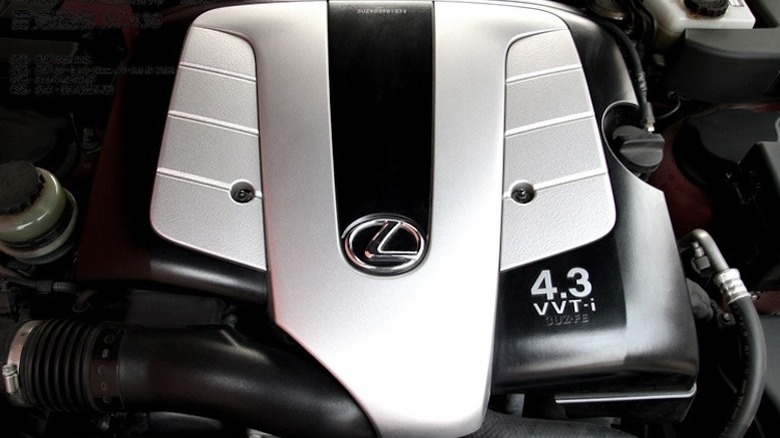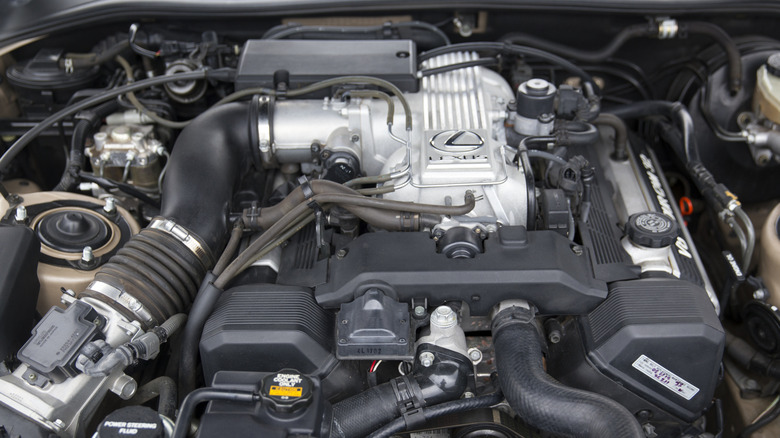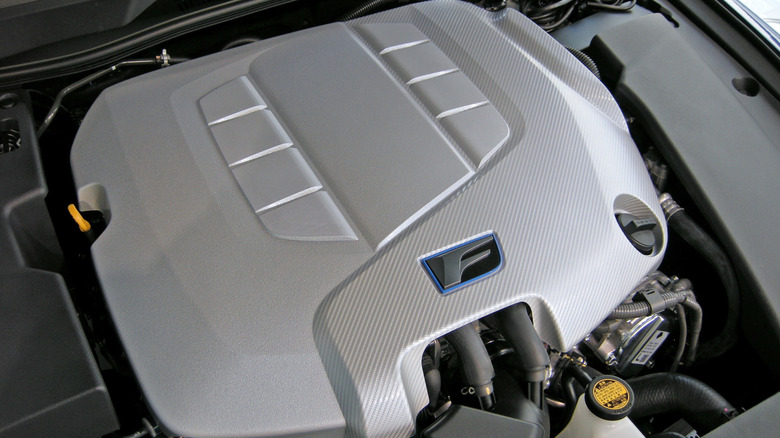Every Lexus V8 Engine, Ranked From Most To Least Powerful
Toyota established its luxury brand Lexus all the way back in 1989. In the last 35 years, the Japanese automaker has become not just one of the most stylish manufacturers of vehicles but also one of the most dependable automobile brands on the market. It may not have the history of other luxury brands like BMW or Mercedes-Benz, nor the novelty factor of a Tesla, but Lexus has carved itself out a space because so many people are drawn to the aesthetics and reliability of the various Lexus models.
However, there is not as much talk about what powers these vehicles. Going all the way back to 1989, Lexus has been utilizing a variety of V8 engines in its cars which are among the most powerful engines the company has ever used for its vehicles. None of these V8 engines are exclusive to Lexus, as Toyota will use them in other vehicles, but just because they aren't luxury exclusive doesn't mean they aren't worth having under the hood. Lexus has used eight different V8 engines for its vehicles, all of which have their own output capabilities. We will go through the horsepower and torque specs of each of these engines to rank them by how much power you can expect.
5.0L 2UR-GSE
When it comes to power, there is really only one Lexus V8 engine that could top this list, and it is an engine that the company still uses in some of its vehicles today. This would be the 2UR-GSE V8 engine, the second-most powerful engine ever built by Toyota. The UR is the engine family name that Toyota first introduced in 2006 and has continued production ever since. To further break down that name, the 2 indicates that this is the second generation of this particular engine, the G signals a performance cylinder head, the S means it utilizes D4-S gasoline direct injection, and the E indicates multi-point fuel injection.
The 2UR-GSE first made its way under the hood of a Lexus in the 2008 model year with the Lexus IS F. This vehicle did not have a terribly long run, as it came to an end in 2014, but that doesn't mean you couldn't get some serious power with this 5.0L V8 under the hood. Initially, it had an output of 416 hp and 371 lb-ft of torque. Those numbers alone wouldn't make it top this list, but Toyota and Lexus continued to use this engine after the IS F. It can now be found in the Lexus LC 500 and its F-Sport Performance trim, the RC F, and the GS F. Through further refinements, the 2UR-GSE can now reach up to 471 hp and 398 lb-ft of torque. Those are the kinds of numbers that get you to the top.
5.0L 2UR-FSE
The GSE was not the only second generation model in the UR V8 family. Right alongside that was the Lexus 2UR-FSE. Instead of a performance cylinder head, this particular model just used a normal one. Outside of that, the two engines are incredibly similar, even having the same volume of displacement at 5.0L. It is predominantly because of that cylinder head why this falls short of the GSE model in terms of power. The 2UR-FSE could generate up to 394 hp and 383.5 lb-ft of torque. These are entirely respectable numbers, but they just lag a little behind the top engine on this list.
That being said, these numbers are a little misleading because of what vehicle this engine was used for. Lexus installed this under the hood of the Lexus LS 600h, a hybrid vehicle that hit the market in 2007 and lasted through 2017. This is the only V8 Lexus has used for a hybrid, and when the 2UR-FSE is paired with the Lexus Hybrid Drive system, those raw engine specs are elevated to an output of 438 hp. Whether you are judging it based on its actual power or its practical power with the hybrid motor, it earns second place on this list.
4.6L 1UR-FSE
The UR family of V8 engines kicked off in earnest in 2006 with two first generation models. The two are quite similar to each other, but when it comes right down to it, the more powerful one is the 1UR-FSE engine. This has all of the same properties as the previous FSE engine on this list — with the normal cylinder head, D4-S direct injection, and multipoint fuel injection — but it is a slightly smaller displacement at 4.6L. With that smaller size comes an ever so slight decrease in performance output.
The 1UR-FSE is able to handle up to 385 hp and 369 lb-ft of torque. While not exactly great numbers for a sports car, that isn't what this engine was used for. Initially, this went underneath the hood of the Lexus LS 460, which is a four-door luxury sedan. For that kind of car, it's quite a lot of power. Two years later, Lexus would use it for the GS 460, another four-door executive car. That vehicle only lasted through the 2011 model year, so it didn't get a long run with the V8. However, the LS 460 and 460 L — its longer trim — would utilize the 1UR-FSE through 2017. A new generation of the LS would begin the following year, and it switched out the V8 for a V6 engine, which is still the case to this day.
5.7L 3UR-FE
Although the naming conventions of Toyota engines indicate that the first number you see is what generation it belongs to, that sometimes does not paint an accurate portrait of a timeline. The 2UR engines previously mentioned debuted in the 2008 model year, and that is actually the same year that saw the 3UR-FE V8 engine make its way into Lexus vehicles as well. This is a larger 5.7L engine featuring the same multipoint fuel injection as the previous engine with a normal cylinder head. You might think that because its displacement is larger it'd be more powerful than the 2UR-GSE, but it falls just a tad short.
The only Lexus to ever use this engine was the Lexus LX570, which debuted for the 2008 model year. Where the 3UR-FE actually does outperform the 2UR-GSE is with its torque capabilities, able to generate up to 401 lb-ft of torque. The reason it falls to fourth place on this list is just because it has an output of 381 hp, which is a significant step back from its contemporaries. The LX570 went away after the 2021 model year, and the 3UR-FE went along with it. Now, the LX models use a V6 engine instead.
4.6L 1UR-FE
The reason why there were two first generation UR V8 engines was because of different markets. The 1UR-FE was originally meant just for the Middle East for those Lexus LS and GS models, while the aforementioned 1UR-FSE was more predominantly used around the world. However, Lexus decided to bring the FE version, which does not feature the D4-S gasoline direct injection capabilities, to North America for the 2010 model year. It was put under the hood of the Lexus GX 460 and would actually be used through 2023, after which Lexus revamped the SUV for a new generation. This current generation instead has a V6 engine.
The 1UR-FE performed much better in the Middle East models, achieving an output of 342 hp and 335 lb-ft of torque. In the North American Lexus GX 460, those numbers were slightly lower at 301 hp and 329 lb-ft of torque, but it is a much larger vehicle that it needs to power. Furthermore, this engine marks the final entry of the UR family of V8s.
4.3L 3UZ-FE
The UR engine family is not the only group of V8s that Lexus would put inside of its vehicles. After all, it didn't exist prior to 2006. For model years ranging from 1989 all the way to the end of the 2000s, Lexus would instead go to that family's predecessor, the UZ V8 engine, for this power. Unlike the UR engines where the generation timeline is a little fuzzy, the UZ generations work in a much more linear fashion, where each one looked to be an improvement on the last while retaining most of the same properties.
It makes sense that the most powerful of this family would be the 3UZ-FE V8 engine. This engine found its way into three different Lexus cars for the 2001 model year: the Lexus LS 430, the GS 430, and the SC 430. The 430 in all of those names references the 4.3L V8 that powers them. Even the newest, most powerful UZ engine model couldn't reach the might of the lowest UR engine, but the difference between them is rather small. The 3UZ-FE had an output of 300 hp and 325 lb-ft of torque.
Lexus would gradually fade this engine out over the 2000s, as the UR family started taking its place. It was out of the LS after 2006, and the GS the following year. However, it would make it all the way to the end of the SC model in 2010.
4.0L 1UZ-FE
This 4.0L was the very first V8 engine Lexus used, going all the way back to the 1989 Lexus LS 400. Two years later, the company would use it for the Lexus SC 400, which would be followed by the GS 400 in 1997.
Importantly, this engine underwent a modification in 1997, as Lexus added VVT-i (Variable Valve Timing with intelligence) to the 1UZ-FE. On its initial launch, the V8 had a power output of 256 hp and 260 lb-ft of torque. Those numbers are quite pedestrian compared to what else is on this list, but that doesn't tell the full story of the 1UZ. When the 1997 VVT-i version came around, the output went up to 300 hp and 310 lb-ft of torque. That places its horsepower rating at the same level as the third generation of this engine. Lexus would phase out the 1UZ-FE V8 engine after 2000.
4.7L 2UZ-FE
Here, we arrive at another instance when an engine being larger does not necessarily mean it is more powerful. The 2UZ-FE has a displacement of 4.7L, larger than its predecessor and successor. Unfortunately, it falls just behind both in the power department. The 2UZ-FE was first introduced for the 1998 model year in the Lexus LX 470 SUV. It would take until the 2002 model year for it to power another Lexus with the GX 470.
This engine also added VVT-i in the mid-2000s, marking two eras for it. Prior to VVT-i, this V8 could generate just 235 hp and 320 lb-ft of torque. That would comfortably place this engine in last place on this list. If you are judging the version with VVT-i, those numbers increase to 282 hp and 325 lb-ft. Even with that boost, it can't match the VVT-i boost of the 1UZ-FE. The Lexus LX would abandon the 2UZ after 2007, but the GX had a longer run with the V8, powering the SUV through 2009.
Methodology
Determining the ranking of this list of V8 engines used by Lexus for its vehicles came down to one factor: horsepower. The higher the rating is for the engine's horsepower, the higher up the list the engine will be. While something like torque is important for judging the true feel of that engine's power, it comes secondary to horsepower. However, if two engines had the same horsepower rating, the engine with the higher torque was placed higher on the list.
Also these are V8 engines used by Lexus. Toyota as a whole has many other V8 engines that it has developed over the years, but not all of them have been utilized in Lexus vehicles. These are the eight V8s that the company has used.
